April 16, 2019 feature
The first direct search for inelastic boosted dark matter with a terrestrial detector
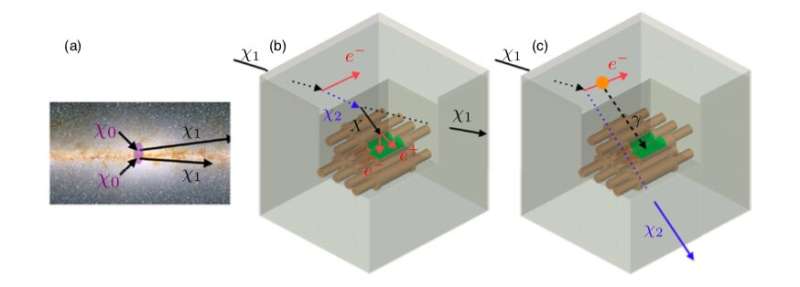
A team of researchers in the Republic of Korea, the U.S., Brazil, Indonesia and the U.K. have recently carried out a direct search for inelastic boosted dark matter (IBDM) using a terrestrial detector. Their study, published in Physical Review Letters (PRL), is the first ever to search experimentally for IBDM using a terrestrial detector.
Observations gathered by past astrophysics studies suggest that the universe's dominant matter component is not ordinary matter, but nonbaryonic dark matter. Researchers have made tremendous efforts in to search for dark matter via direct detection, indirect detection and collider experiments, yet so far, their attempts have been unsuccessful.
This lack of success encouraged them to search for alternative types of dark matter, such as light-mass models or relativistically boosted dark matter (BDM), which would have substantially different signatures in detectors. Precisely because these new kinds of dark matter would produce unconventional signatures, very few of them have been the focus of traditional dark matter experiments.
"Even though scientists have consistently searched for WIMP (Weakly Interacting Massive Particle) dark matter over the past few decades, no clear signals have yet been observed," Hyun Su Lee, a researcher at the Institute for Basic Science in Daejeon, Korea, who carried out the recent study, told Phys.org. "This has motivated searchers for other types of dark matter, which may give significantly different signals in the detector. One idea is searching for multi-component dark matter. In this case, each dark matter component is likely WIMP dark matter, but it has a different mass."

A few years ago, researchers at the University of Maryland and MIT introduced a new model that describes a relativistic dark matter particle boosted by the annihilation of heavier dark matter participles in the galactic center or the sun. According to their model, this would require at least two species of dark matter particles, comprising a multi-component dark matter.
Dark matter candidates with a heavier mass can decay into light dark matter. As mass is equivalent with energy, in the case of multi-component dark matter, mass differences between different components would lead to high speed of light dark matter. The term 'boosted dark matter,' therefore, basically means that incident dark matter has a relatively high velocity.
"The expected signal from high velocity dark matter is energetic electron recoil, while typical dark matter brings low energy nuclear recoil," Lee explained. "This theory has been considerably developed over the past few years. After that, theorists started thinking about inelastic scattering, because of the multiple components of dark matter."
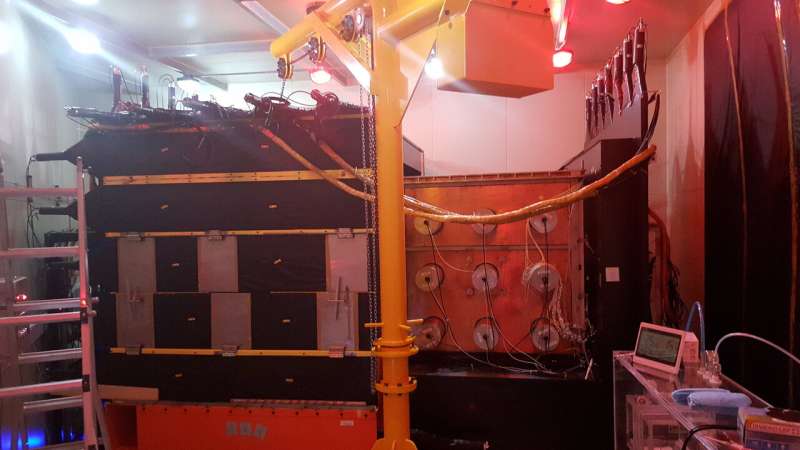
In chemistry and physics, Inelastic scattering is a fundamental process in which the kinetic energy of an incident particle is not conserved, but is either lost or increased. Researchers at CERN, as well as other institutions in Korea and the U.S. have theorized an inelastic interaction of boosted dark matter. According to their theories, relativistic dark matter interacts with the target material through inelastic scattering with electrons, creating a heavier state that later produces standard model particles, such as electron-positron pairs.
"In inelastic scattering, the first energetic electron is produced with an additional dark sector particle," Lee explained. "Such a dark sector particle is decaying into an electron positron pair with some displacement. So far, no experiments have carefully studied these kinds of signals, so we thought that this could be a good alternative scenario to explain the dark matter problem."
In their study, Lee and his colleagues carried out the first direct search for IBDM with a terrestrial detector. Essentially, they immersed eight Nal(TI) crystals with a total mass of 106kg into a 2,200L liquid scintillator surrounded by heavy shields to block radioactive backgrounds.
-
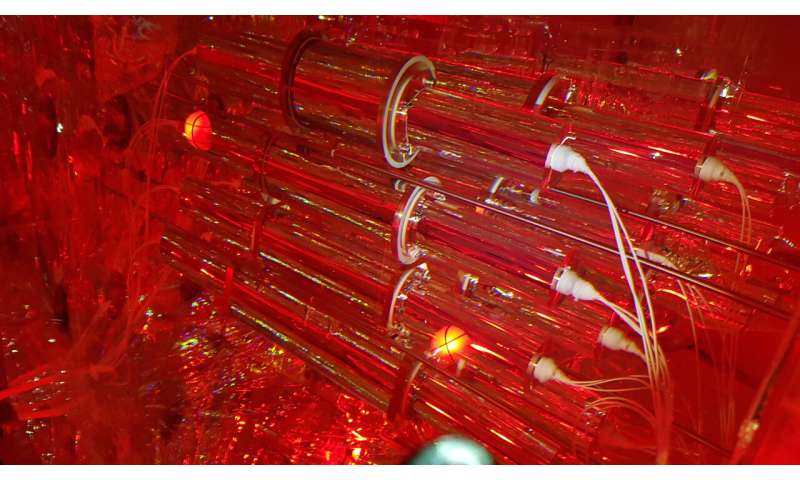
Inside the COSINE-100 detector. Credit: Ha et al. -
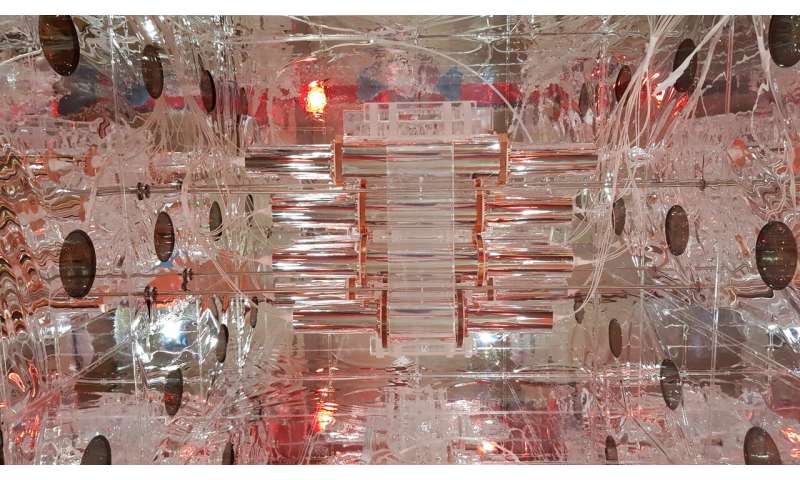
Inside the COSINE-100 detector. Credit: Ha et al. -
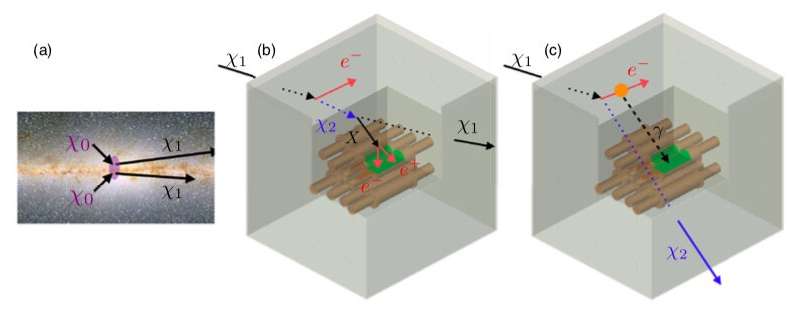
(a) Production of relativistic BDM χ1 in the Galactic center by the annihilation of heavier dark matter χ0. (b) Illustration of multiple-site hits from an inelastic interaction of BDM for the case of two interactions occurring in two different NaI(Tl) and liquid scintillator (LS) detectors. (c) Illustration of bremsstrahlung radiation-induced hits on two NaI(Tl) or LS detectors. Credit: Ha et al.
"We used both NaI(Tl), 106kg, and LS, 2ton, as an active detector to search for one energetic electron plus electron positron pair that deposited energies in two different detector components," Lee said. "Because of the large mass of the detector and its many components, it achieves a relatively good sensitivity for these types of signals."
Unfortunately, Lee and his colleagues were unable to detect IBDM signals in their data. Nonetheless, theirs is a pioneering study, as nobody had previously used detectors to search for this particular type of dark matter.
Their work is part of a greater project, dubbed COSINE-100, which is specifically aimed at testing dark matter annual modulation observed by the DAMA experiment. The researchers think that further searches for IBDM signals using the same detector or other ton-scale dark matter detectors will be more fruitful.
"For the boosted dark matter search, we will improve our analysis by using about 10 times larger dataset that we already have on disk," Lee said. "We also plan to search elastic scattering channels and expect that an updated search will explore large parameter spaces that have not yet been searched in any other experiments."
More information: C. Ha et al. First Direct Search for Inelastic Boosted Dark Matter with COSINE-100, Physical Review Letters (2019). DOI: 10.1103/PhysRevLett.122.131802
(In)direct detection of boosted dark matter. DOI: 10.1088/1475-7516/2014/10/062. iopscience.iop.org/article/10. … 516/2014/10/062/meta
Dark Matter "Collider" from Inelastic Boosted Dark Matter. DOI: 10.1103/PhysRevLett.119.161801.
journals.aps.org/prl/abstract/ … ysRevLett.119.161801
An experiment to search for dark-matter interactions using sodium iodide detectors. DOI: 10.1038/s41586-018-0739-1. www.nature.com/articles/s41586-018-0739-1
Journal information: Physical Review Letters
© 2019 Science X Network




















